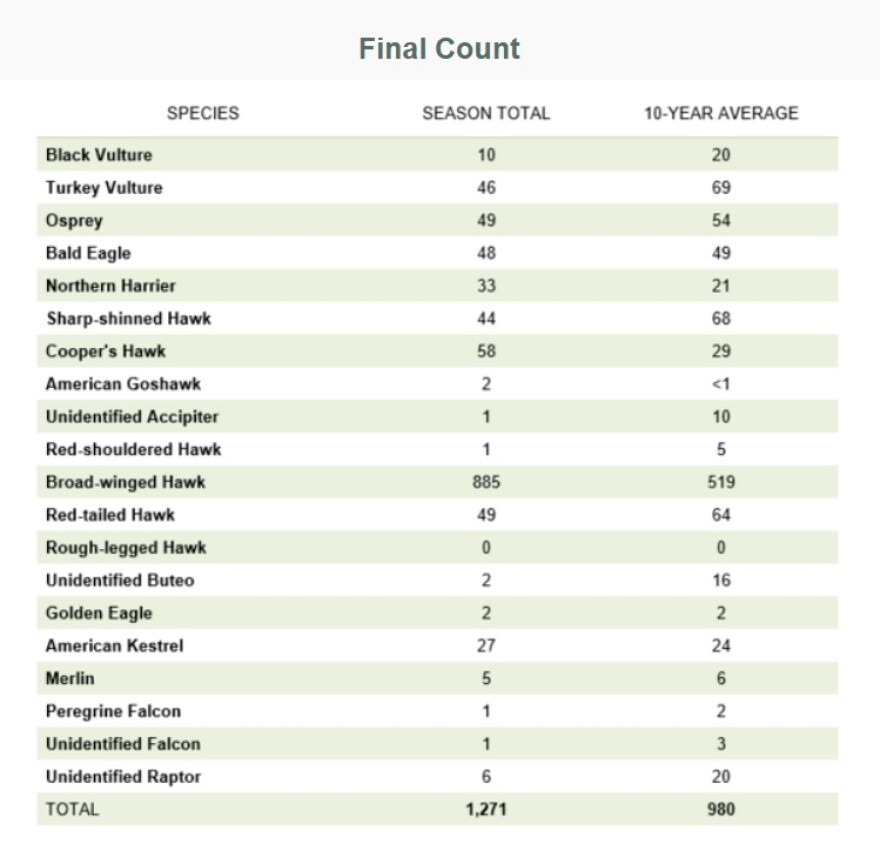ALBANY TWP., Pa. — Hawk Mountain's official spring migration count has ended, with nearly 1,300 trekking birds recorded.
Officials and volunteers recorded 1,271 birds, Count Coordinator David Barber said in a Tuesday newsletter from the Berks County sanctuary. It was 30% above the 10-year average, and the fourth highest spring count recorded.
Staff and volunteers at the sanctuary have monitored the spring raptor migration as part of ongoing conservation research since the 1960s, with an average of about 1,000 raptors each 45-day season, from April 1 through May 15.
“The count ended on a low note with three days of fog and rain,” Barber said. “The last official migrant of the 2025 count was an unidentified raptor on the afternoon of May 12.
“Trainees, staff and volunteers counted 220 hours over 38 days.”

An ‘excellent spring count’
The day with the highest count was April 18, with 581 bird recorded, including: two turkey vultures, six ospreys, three bald eagles, six northern harriers, one sharp-shinned hawk, 12 Cooper’s hawks, 542 broad-winged hawks, five red-tailed hawks, three American kestrels and one merlin.
"The broad-winged hawks count of 885 was 71% above the 10-year average and a new record high."David Barber, count coordinator
“The broad-winged hawks count of 885 was 71% above the 10-year average and a new record high,” Barber said. “The count of 33 northern harriers was 61% above average and the highest count since 2013.”
The final tally of Cooper’s hawks, American goshawk and American kestrels also were above average, according to the newsletter. However, black vultures, turkey vultures, ospreys, sharp-shinned hawks, red-shouldered hawks and red-tailed hawk counts were below average.
All other species had average counts.
Weather, specifically consistent northwest winds, was the “MVP” contributing to an “excellent spring count,” Barber said.
“Several larger storm systems interrupted migrants moving up the Mississippi flyway into the northeast, resulting in a concentrated push of migrants through the region as winds shifted from northwest to south, producing our season high count of 581 on April 18,” Barber said.
“The flight rapidly dwindled as May saw multiple large, occluded fronts wash out the count interspersed with dry, high-pressure systems that provided excellent lift, dispersing the flight and making for challenging count conditions.”
Non-raptor highlights
Other migrating species of birds “trickled through,” officials said, gradually building.
“April into early May saw a strong flight of blue jays moving north along with the expected neotropical migrants,” Barber said. “The stunning rose-breasted grosbeak and scarlet tanager in their alternate plumage complemented the spring warbler flight.
“Both black and yellow-billed cuckoo were seen during the last week of the count along with territorial worm-eating, black-and-white and black-throated green warblers. A red-headed woodpecker flew north past the lookout on May 11.”
Last spring, the count saw a record-high number of bald eagles. Black vulture, sharp-shinned hawks and merlin counts were also above average.
Hawk Mountain’s next count is the annual fall migration, which begins Aug. 15.


